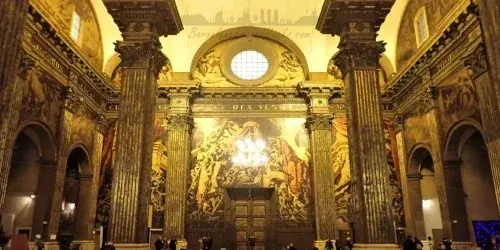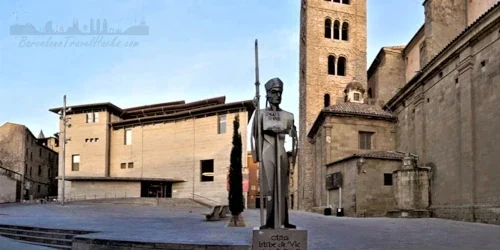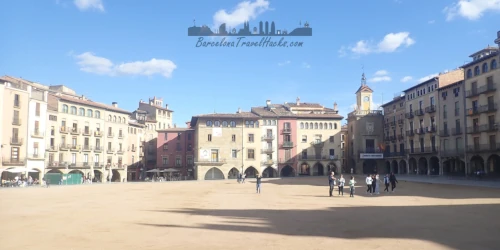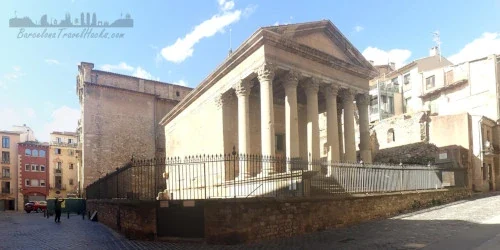Please sign in with Google to view the map.
Sign in with GoogleVic Leather Arts Museum | Museu de l’Art de la Pell de Vic
Explore Vic’s leather heritage at the Museu de l’Art de la Pell. See chests, Cordovan boxes, guadamassil panels, and furniture from Andreu Colomer Munmany’s collection
About the Museu de l’Art de la Pell de Vic
The Vic Leather Arts Museum (Museu de l’Art de la Pell de Vic) celebrates the city’s centuries-old tradition of leather production. Located in the restored Convent of the Verge del Carme, the museum houses the private collection of Andreu Colomer Munmany, a visionary industrialist and global ambassador for Vic’s leather industry. The collection spans continents and centuries, showcasing the artistic, cultural, and functional uses of leather in furniture, religious art, travel chests, and more.
Vic was once home to over 25 tanneries, most concentrated near the Queralt Bridge. Today, many of these historic buildings are being restored and repurposed as cultural spaces, reinforcing Vic’s identity as a centre of leather craftsmanship in Catalonia.
History of Andreu Colomer Munmany & Leather in Vic
The Colomer Munmany family has been at the heart of Vic’s leather industry since 1792. Over generations, they transformed a local tannery into a global enterprise, pioneering techniques like sulphur tanning, white tanning, and chrome salt processing. Under Andreu Colomer Munmany’s leadership, the company expanded internationally, with operations in Europe, Asia, and Latin America.
Andreu’s contributions extended beyond business. He served on national and international leather councils, led trade missions, and collaborated with the Episcopal Museum of Vic for over 40 years. In 1996, his lifelong passion for leather artistry culminated in the opening of the museum, preserving a legacy of craftsmanship and innovation.
- 1792: The Munmany family establish a tannery in Vic.
- 1858: Advances in chemical research brought the introduction of chrome salts in the leather production process transforming the leather industry from a craft into an industrial sector.
- 1884: Josep Colomer i Costa was born in Vic and was a blacksmith. After a year of marriage to Carme Munmany he inherited the Munmany family tannery and started working in the industry.
- 1900: Manuel Portavella (chemist) joins the company as Colomer Munmany's technical director to develop technologies and specific methodologies such as sulphur tanning for dry pickling, white tanning for coating, and the use of sodium silicate to produce articles that were soft to the touch. This pioneering process fueled Colomer Munmany's international expansion and reputation as the producer of the best quality entrefino leather for garments and gloves.
- 1913: Andreu Colomer Munmany is born in Vic, son of Josep and Carme, third born of 9 children. four boys and five girls. Andreu Colomer, together with his brothers Ramon and Rafael, founded Colomer Munmany SA, the origin of the Colomer Group.
- 1936: At the start of the Spanish Civil war the the Colomer Munmany Tannery has thirty workers.
- 1939: The Colomer Munmany family returns from exile in Belgium at the end of the Spanish civil war and took charge of the tannery business.
- 1942: Andreu Colomer Munmany marries Pilar Guanyabens Baró producing a daughter.
- 1948: Appointed member of the National Executive Committee for the Centenary of the death of Jaume Balmes.
- 1950s: Starting a 40 year long collaboration with the Board of Governors of the Episcopal Museum of Vic
- 1957: creation of the Consorcio del Comercio Exterior de la Piel to influence government policy under the Dictator Franco and try and control import quotas of leather.
- 1962: Promoted the formation of the Asociación de Investigación de las Industrias del Curtido y Anexas (Tanning and Related Industries Research Association) to modernise leather production and
- 1960´s & 1970's: Epansion of the Colomer Munmany SA buisness by acquiring companies in the sector (Ernesto Baumann, Anónima Lanera, Comercial Italo Española, Máximo Mor & Andreu Sala). Foreign investments in overseas production (Pakistan, Nigeria, Lebanon, Greece, China , Brazil, Mexico & Iran).
- 1968: Awarded the command of the Order of Cisneros in recognition of his export activity.
- 1970: Appointed member of the Consultative Board of the Employers Association of Accidents at Work, Asepeyo. From 1990 to 1996, he held the position of president.
- 1971: Presided in Vienna at the III Session of the United Nations Industrial Development Organization.
- 1974: Awarded the Cultural Merit Medal by the Diputación de Barcelona.
- 1977: Presided over the first Spanish commercial mission to China.
- 1978: Elected president of the International Council of Tanners, based in London, an organization of which he was honorary president in 1982.
- 1979: Elected president of the Advisory Board of the Port of Barcelona.
- 1990: Awarded the Cross of Sant Jordi by the Generalitat de Catalunya.
- 1988: He was named president of the Spanish Leather Council.
- 1991: The commitment to transfer the assets of the Andreu Colomer leather arts collection to the Generalitat de Catalunya was formalised.
- 1996: Inauguration of the Museum of Leather Artistry in the former ruined convent of Verge del Carme
- 1988: He was named president of the Spanish Leather Council.
- 2003: Colomer Munmany SA has a sales volume of 132 million euros, with participating companies in Spain, France, Japan, Greece and England, and a combined workforce of eight hundred and seventy employees.
- 2006: Colomer Munmany opened the Baumann plant in Vic. A major investment in modernisation and automation of the leather production process consolidating all the finished article production lines in to a single plant.
- 2009: The Chinese multinational Henan Prosper (sheepskin tanning and sheep wool production) bought the Colomer Munmany finishing plant.
- 2019: Colomer 1792 opened a new 5,000m2 leather warehouse for distribution throughout Europe in Les Masies de Voltregá (10km from Vic).
Image Gallery For Vic Leather Arts Museum
Click on any of the 70 images to open full screen gallery player. Note that viewing images is subject to our Fair Use Policy.
Visiting the Vic Leather Arts Museum
The museum’s collection is a treasure trove of decorative leather arts from across the globe. Highlights include:
- Leather-lined chests and trunks: Used since medieval times for travel and storage, often reinforced with iron and designed with arched lids to repel rain.
- Guadamassil panels: Gilded and polychrome leather artworks originating from Andalusia, used in altar fronts, wall coverings, and devotional images.
- Cordovan leather boxes: High-quality goatskin leather from Córdoba, used for jewellery cases, liturgical objects, and gifts of courtly love.
- Portuguese leather chairs: 17th–18th century embossed leather furniture used by nobility and clergy, featuring heraldic and floral motifs.
- Shadow puppets and religious figures: Embossed and painted leather sculptures depicting saints, angels, and biblical scenes.
The museum’s interpretive panels provide detailed context for each piece. While there is no audio guide, the collection is self-guided and easy to navigate.
Vic Leather Arts Museum Opening Hours
- Tuesday to Friday: 10:00 am to 2:00 pm & 4:00 pm – 7:00 pm
- Saturday: 11:00 am to 2:00 pm & 4:00 pm to 6:00 pm
- Sunday: 11:00 am to 2:pm
- December 24th & 31st, January 1st & 6th: 09:00 am to 2:00 pm
- Closed: Mondays, December 25th & 26th
Accessibility & What to Bring to Vic Leather Arts Museum
The Vic Leather Arts Museum is fully accessible, with ramp access at the entrance and elevators connecting all floors. Gradual incline ramps make it easy to navigate for wheelchair users and visitors with reduced mobility.
For your day trip to Vic, bring a small 10L rucksack with a fleece or light jacket. If rain is forecast, pack a waterproof poncho. Comfortable walking shoes are recommended, especially if you plan to explore other nearby attractions.
Vic Leather Arts Museum Summary of Prices
Getting to Vic Leather Arts Museum
Address: Carrer de l'Arquebisbe Alemany 5, Vic, 8500
Vic is located about 90 minutes from Barcelona and is easily accessible by public transport.
Train: Take the Renfe Rodalies R3 Line from Barcelona Sants or Plaça Catalunya. Trains run every 45–60 minutes from 06:00 to 22:00.
Bus: The e12 Sagales bus from Barcelona Sagrera reaches Vic in about 60 minutes. Buses are more frequent during weekday rush hours.
Tickets: You can buy tickets online via the Sagales website, use a 6-zone T-casual or TT-usual card, or pay the driver in cash.
Map forVic Leather Arts Museum
Weather for Vic Leather Arts Museum
Where to stay near Vic Leather Arts Museum
Nearby Attractions to Vic Leather Arts Museum
 TRAIN
TRAIN
Vic Cathedral: Romanesque & Gothic Landmark in Catalonia
Explore Vic Cathedral’s Romanesque bell tower, Gothic cloister, and Sert murals. A must-see day trip from Barcelona in the heart of historic Vic
Read more >
 TRAIN
TRAIN
Museu Episcopal de Vic: Medieval Art in Catalonia
Explore 29,000 medieval artefacts at MEV Vic, including Romanesque sculpture, Gothic painting, jewellery, and textiles. A top day trip from Barcelona
Read more >
 TRAIN
TRAIN
Vic Town Centre Walking Guide: Plaça Major & Historic Sites
Explore Vic’s medieval town centre on foot. Visit Plaça Major, Roman ruins, Baroque houses, and iconic buildings on a scenic walking route from Barcelona
Read more >
 TRAIN
TRAIN